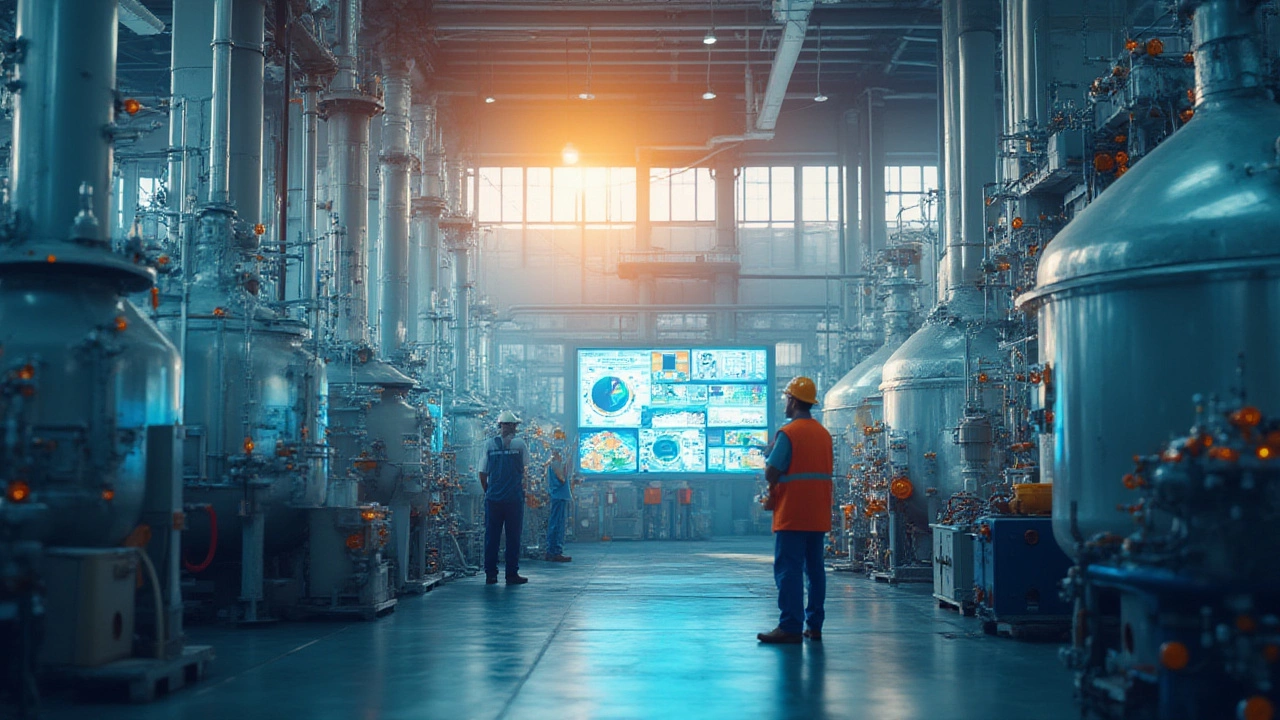 Jul, 18 2025
Jul, 18 2025
Butter cost more this year, and so did your shampoo. Ever thought about what’s really driving these prices up and what’s blending into all those daily essentials? It’s the chemicals behind the scenes—some ultra-basic and some with names you can barely say. Yet, these chemicals are the real muscle behind everything from medicine to the tire on your bike, and they're in hotter demand than ever in 2025.
The Chemical Rockstars: Top Demand Leaders
It’s not just oil that steals headlines. Walk into any plant right now and you’ll find producers scrambling to meet orders for acids, plastics, and solvents. The big leader? Sulfuric acid. This stuff is the unsung hero—used to make fertilizer for the crops that feed the planet. Nearly 260 million metric tons are churned out worldwide every year, making it the most produced chemical by volume. Mike, a friend of mine who manages a fertilizer shop, jokes it’s "liquid gold"—but with less luster and way more bite if you spill it on your shoes.
Ethylene is next in line. Pull up the stats, and you’ll see global production hit over 180 million metric tons. Why? It’s the backbone for all those plastics, pipes, bottles, and even the cling wrap keeping your leftovers fresh. Another biggie: ammonia. Mostly turned into fertilizers, it helps squeeze more food out of every acre thanks to its nitrogen punch. The demand is so sky-high, we're seeing new plants pop up in places you wouldn’t expect, like Texas and the Middle East, all racing to keep up with the world’s appetite for cheaper groceries.
If these names feel industrial, don’t worry—everyday stuff you use is also packed with high-demand chemicals. Think of propylene glycol (found in deodorants and ice cream), chlorine (in your tap water and pool), and acetic acid (the guts behind cleaning supplies and vinegar). These regulars fly off the shelves by the truckload, driven by everything from food preservation to new green cleaning trends.
Want proof? Here’s a snapshot of global production from last year in metric tons:
| Chemical | 2024 Global Production (million MT) | Main Use |
|---|---|---|
| Sulfuric Acid | 260 | Fertilizers, batteries |
| Ethylene | 180 | Plastics (PE, PET), solvents |
| Ammonia | 180 | Fertilizers |
| Propylene | 120 | Plastics (PP), other chemicals |
| Chlorine | 70 | Disinfectants, PVC |
Here’s a tip: if you see a plant going up in your town, and it has tanks labeled SA or NH3, those are shorthand for sulfuric acid and ammonia. That means big fertilizer business, and probably plenty of work for local truckers or pipefitters.
What’s Fueling the Demand?
The world’s hunger for chemicals always ties back to three things: food, water, and stuff. Think about it—no fertilizers, no food; no plastics or coatings, and half the things in your cupboards vanish overnight. Population growth alone pushes chemical demand higher each year. The UN expects us to add over a billion new people by 2050, and each one will want more packaged food, clothes, even smartphones. Agriculture especially leans hard on ammonia and urea, both nitrogen-rich chemicals, to keep fields productive.
Cleaner energy matters too. In 2025, chemicals like hydrogen peroxide and ethanol got a bump thanks to stricter emissions rules and all those new battery plants for electric cars and grid storage. Even established players had to adapt. For instance, the chlorine industry amped up capacity to sanitize water faster in fast-growing cities. And propylene? EVs use more plastic than traditional cars, putting more pressure on manufacturers to up their game. Every electric sedan you spot on the road quietly increased demand for propylene glycol and ethylene polymers.
Supply chain hiccups, like what happened during the pandemic, usually turbocharge demand even more. Plants run full tilt for months, buyers stockpile, and prices spike. But it’s not always a smooth curve. Just last year, a major fire at a Texas chemical plant caused a sudden shortage of polypropylene, and prices jumped overnight. If you work in construction or packaging, you felt it—projects delayed, and plastic sheeting became as rare as hen's teeth.
So, what’s the tip for businesses here? Diversify your supplier list and build relationships with producers in different regions. That way, you’re not standing in line when a single plant goes offline.

Sectors Driving the Craze for Chemicals
If you follow the money, you'll find chemicals at the heart of some of the fastest-growing industries. The first is agriculture—no surprise, given the global fight to end food shortages. Fact: Over 85% of all ammonia produced ends up as fertilizer, and one out of every two people alive today relies on fertilizer to eat, according to the International Fertilizer Association. Try to wrap your mind around that for a second.
Next is plastic manufacturing. Polyethylene, polypropylene, and polyvinyl chloride (PVC) all start with simple petrochemicals like ethylene and propylene. No wonder giant plants from China to Germany crank these out day and night. Additives like phthalates and bisphenol-A are also in demand—they give plastics flexibility or clarity, letting them find a home in toys, medical tubing, and food containers.
Tech and electronics are not left out. Ever noticed how your phone keeps shrinking, batteries last longer, and screens get brighter? Chemicals power all that progress. Lithium, cobalt, and special solvents make today’s batteries lightweight and powerful. Semiconductors rely on super-pure silicon, which starts from industrial chemicals like trichlorosilane and hydrogen chloride. With AI servers lighting up data centers everywhere, demand for these niche chemicals keeps ticking higher.
Pharmaceuticals make another big slice of the pie. Cancer drugs, antibiotics, and vaccines all need complex molecules—often synthesized in multi-step chemical reactions. Simple stuff like ethanol and acetone are essential for cleaning lab equipment or extracting key ingredients. There’s even a fascinating push for 'greener' additives, like biodegradable solvents, to help labs reduce waste. Emily always teases me about how our medicine cabinet is basically a snapshot of the chemical market.
A quick list of industries thirsty for chemicals:
- Agriculture (fertilizers, pesticides)
- Construction (plastics, paints, adhesives)
- Automotive (synthetic rubber, plastics)
- Pharmaceuticals (active ingredients, solvents)
- Textiles (dyes, polyester, finishing agents)
- Electronics (semiconductors, batteries, display materials)
- Food processing (preservatives, emulsifiers)
Trends, Risks, and Future Shifts
The chemical market isn’t just about who moves the most tons—it’s about what’s changing. Sustainability is gaining ground. Europe, the US, and parts of Asia are setting tough new rules for emissions. That’s pushing up demand for bio-based chemicals, like bioplastics made from corn or sugar, and green solvents that break down less nastily in rivers and soils. Fun fact: bioplastic production jumped by 10% this year. Big brands are sniffing around, hoping to cash in on eco-friendly packaging.
Digital tech is also reshaping this space. Chemical plants are going high-tech: automation, remote sensors, AI-driven process control. This makes production cleaner and faster, but it also means the *strongest* demand isn’t just about raw volume—it’s about high-purity, custom blends tailored for specific products. If you know a chemical engineer, ask what’s changed in the last five years, and odds are, they’ll talk your ear off about automation or new regulations keeping everyone on their toes.
Then, there’s the risk angle. Chemicals are global, but supply chains can turn fragile in an instant. Earthquakes, factory fires, or shipping delays have knock-on effects that hit prices and even force companies to switch to alternatives—sometimes at a huge cost. That’s why investors and buyers are looking for more stable regions or even "friendshoring," where you supply chemicals from politically aligned countries.
What about jobs? More plants mean more skilled trades—plant technicians, chemists, even truck drivers like my cousin Tom. There's also a push to train people on safety and sustainability since accidents can get expensive, fast. Watch for job postings in chemical hubs like Houston, Antwerp, Shanghai, or Mumbai—they’re hiring, big time.
One last bit of advice for anyone curious about breaking into this field: brush up on digital skills and learn the basics of green chemistry. The market pays extra these days for people who know how to save energy, recycle waste, or switch from oil-based to bio-based processes.
Everything from Rex’s chew toy to the paint on your kid’s bike traces back to these fast-moving chemicals. If you keep an eye on who’s making what—and why—it gets a little easier to predict where the next opportunity will land, or why your everyday buys suddenly cost a few bucks more. The world runs on chemicals, even if we rarely give them a thought—until prices jump, or the shelves go bare.